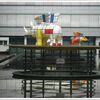
Panel of a Dowry Cabinet / Taefelung eines Hochzeitsschranks
An antique piece of furniture gracing the hotel hallway, amazingly with a Hippocrates aphorism in latin on it. The dad of this girl can't have been a farmer of average education... / Ein antikes Moebelstueck als Dekoration im den Gaengen des Hotels, merkwuerdigerweise mit Hippocrates Zitat auf Lateinisch darauf. Der Vater dieser Braut kann kein eher maessig gebildeter Bauer gewesen sein... |
|







5 comments so far...
De kunst is lang, het leven kort –
En ’t werk van vluchtige uren,
Dat zonder strijd verkregen wordt,
Zal slecht den Tijd verduren.
De kunst is lang, maar kort de tijd
U, voor uw taak, gegeven,
Zoo spil uw kracht in lust noch nijd;
Niet velerlei uw hart gewijd!
Maar ’t éénig kunstwerk ál uw vlijt –
Of ’t u mocht overleven!
But I am not really sure it is the other 2/3rd what is on the other vase. All I can say it are more text, smaler letters in a rather unreadable state of chipping and the camera saw alas not better than the eye for later reconstruction.
The first part of the quote was often expanded upon from the humanistic educated circles and from fine artists, interpreting it differently. And there was of course derivative poetry, not only the one you found, finally even some 60's rock album choosing it as name....
How it gets on the dowry cabinet of some rural maiden in a very catholic area not so long after the onset of minimal compulsory education, not in her native language but in latin? That is really something to ponder about a bit.
In some way saints or their atributes in the upper door panels and just floral decoration in the lower ones was around 1820 in the alpine foothills not uncommon, There is one on Wikipedia from the Chiemsee for example, barely 5 years newer, with exactly the same sacred hearts of Mary and Jesus theme on top and classicist vases with handles below, having nicer and richer painting and showier forms but poorer and far less writing: https://upload.wikimedia.org/wikipedia/commons/e/ee/Schrank%281825%29.JPG And there are also enough at the antique sellers sites that follow the rough pattern of this. So this seems just well within the norm, to mix classicist accessories in still life with the religious parts.
Obviously Maria Walburga's cabinet was painted by a dude who sported a very fine and professional handwriting, almost like printed. Perhaps decorating the vases in antiqua letters and not just meanders was just something he did to set himself appart from painters who had other special skills... ;o)
Already in 1711 lived a man named Hans Adam Schaller in Buerserberg who exchanged letters with authority that survived. The matter was the desire of a own church and parish and eventual emancipation of this smal farming hovel up the Alvier from the difficult to reach comunity of Buers down in the Ill valley it was a dependant part of. So we can know now, there where erudite and articulate commoners of this lastname close by already before the Habsburg empire had made basic school education compulsory -- whole 89 years before Maria Walburga Schaller got married and had her painted new cabinet with the greek quotes on the vases brought to her groom's house!